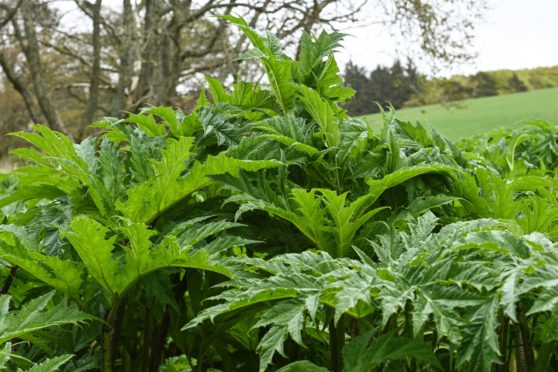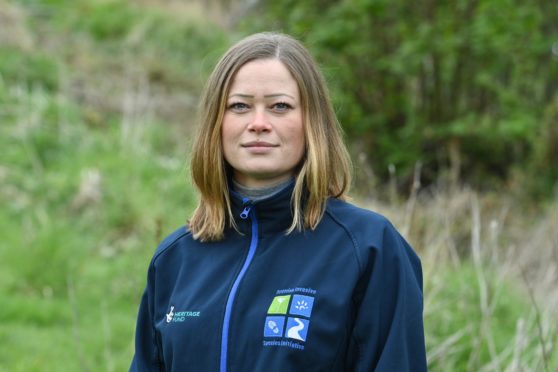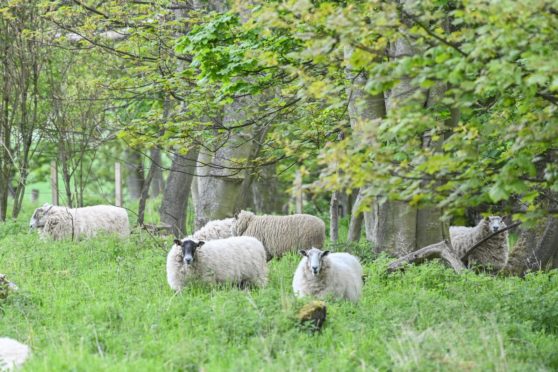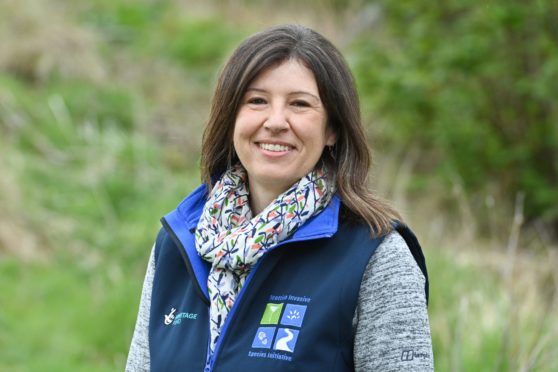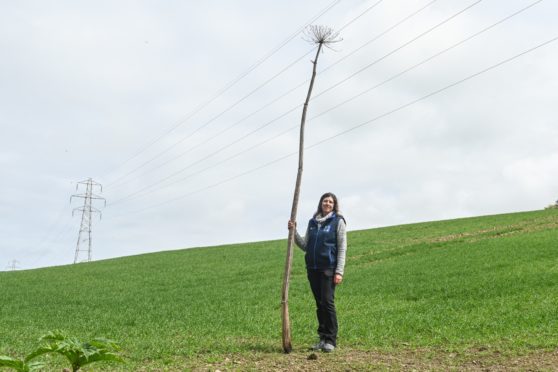On a quiet riverbank just south of Macduff lies a new secret weapon in the fight against poisonous giant hogweed: a flock of sheep.
In the shade of the trees this colony of sheep have developed a taste for the invasive plant, munching down stems until they are little more than stumps in the ground.
But the sheep didn’t get there by accident.
The Scottish Invasive Species Initiative (SISI) are at the root of this ingenious project, and over the last three years have been testing the feasibility of using sheep to control this insidious plant.
Known for its toxic sap that can cause burns, blisters and even blindness, giant hogweed is a non-native species which has been spreading uncontrollably across Scotland for decades.
For years landowners have waged chemical warfare on this giant weed but with little long-term success.
Now, however, it appears the solution to tackling one of the country’s most loathed plants may have been quietly grazing in the local farmer’s field.
What is giant hogweed?
Giant hogweed is one of the worst offending invasive species in Scotland.
It can easily grow two metres tall, forms dense, impenetrable stands and will outcompete all nearby plants, destroying natural flora and fauna.
Originating from the lower reaches of Russia and Georgia, this plant arrived in the UK back in the 1800s.
The Victorians loved its impressive clusters of white flowers, massive leaves and thick, towering stalks, while its Caucasus Mountains origins offered an exotic twist to their ornamental gardens.
Giant hogweed may have been all the rage in the 19th century, but few Victorian gardeners could have suspected they were cultivating a monster that would go on to invade riverbanks, pastures and wasteland the length and breadth of the country.
Its phototoxic sap burns the skin of anyone who touches it and so is a serious hazard for walkers, anglers and anyone trying to enjoy the countryside
But while humans and other animals such as dogs must steer well clear, giant hogweed isn’t poisonous to all.
Sheep are immune to its aggressive sap, and the SISI are currently in the final year of a practical experiment investigating how best land managers could use sheep to control giant hogweed.
With the River Deveron rushing by in the background, Karen Muller, a project officer at SISI, has been working at this site since the project began and says the team have learned a lot in that time.
“This is the third year of the project. In 2019, we started off with a larger number of sheep – 25 – grazing for a longer time.
“That was the first time they (the sheep) had encountered giant hogweed so it took them a little bit of getting used to and they had to be kept in a park for a little while until they really developed that taste for giant hogweed.
“But once we let them loose they did a really, really effective job of grazing the giant hogweed on the site.”
Giant hogweed thrived during lockdown
She explains how the sheep did too good a job, clearing the area of hogweed but also munching on everything else in their paths.
This type of overgrazing is detrimental to the biodiversity of the area, so the team made changes.
“In 2020 we reduced the number of sheep and reduced the number of sheep grazing days by about half, to see what would happen then,” Karen said.
But a mild winter and long periods of heavy rain turbocharged the spread of giant hogweed on Scotland’s river banks and the Covid-19 lockdown made tackling the problem even harder.
With lockdown restrictions in place, Karen and her colleagues were unable to monitor the site as they usually would.
Luckily, however, the sheep weren’t subject to stay-at-home orders and the farmer herded them onto the test site over the summer.
“What we found is that the sheep still really effectively grazed the giant hogweed and they overgrazed the rest of the vegetation to a lesser extent,” said Karen, “but there was still some overgrazing going on.
“So this year we are keeping 12 sheep on-site and we are cutting the sheep grazing further – so actually compared to 2019, that’s actually about a 70% decrease and we are looking at if the sheep will still graze the hogweed effectively and what that does to the rest of the vegetation.”
Throughout the summer the team will be back to monitor the sheep’s progress.
In autumn, a final count will be done to measure exactly how effective the sheep have been at grazing the hogweed.
It is expected that the number of giant hogweed plants will reduce, as was recorded in the previous two years, but this doesn’t mean the hogweed is under control.
“Sheep grazing the plant once or even twice won’t kill the hogweed,” said Karen.
“It needs to be a continuous effort over several years until the taproot’s energy has been entirely depleted.”
Like carrots and dandelions, giant hogweed grow from a taproot.
These long, thick roots are deeply anchored in the soil and contain enough energy to regrow the plant several times until it finally dies.
Every time a plant is munched away by sheep, it must use more and more energy to return until it eventually dies off.
Using sheep to control giant hogweed could become commonplace
The hungry sheep may have been supplied by a local farmer, but SISI have been the ones leading the charge on this innovative project.
Funded by the National Lottery Heritage Fund and Nature Scot, the organisation has partnered with Aberdeen University to work with landowners and fisheries trusts across the country to control all sorts of invasive species
“We’ve got a target number of species we’re looking at, including some large plants and the American mink,” said Vicky Hilton, volunteer and communications officer.
“We are working with volunteers and communities and doing some innovative projects like this to try and come up with sustainable, long-term solutions for controlling invasive species.
“Giant hogweed is quite difficult to control because it’s got a taproot underground and so many seeds to spread.
“The traditional way of controlling it is by spraying it with herbicide and we try and do that at this time of year while the plant is still small.
“But obviously adding a lot of pesticides and herbicides into the environment isn’t the best thing, which is why on this site, we are looking at a different way of tackling it by using sheep which is a lot more environmentally friendly.”
The experiment has proven that sheep definitely have a taste for giant hogweed and that grazing can reduce the spread of the plant and eventually kill it off entirely.
Once this summer is over, the SISI will be putting together some practical advice to help farmers and landowners recreate their success on their own estates.
“The guidance is coming out in early 2022 and will be for anyone who manages a bit of land – farmers, land managers, landowners who have already got some sheep and a bit of hogweed on their land and who think this is something that they could use and put into practice,” said Vicky.
“Some farmers farm organically now so don’t want to use pesticides on their land, some just have a little bit of a hogweed problem, so we are hoping that anybody and everybody across the country might pick this idea up and try it and see if it works for them.”
It’s not just landowners who can get involved. The SISI are currently recruiting volunteers from across the north-east who might be interested in helping to tackle invasive species in their community.
“By having local people who are enthusiastic about doing it such as anglers, members of the community, people in conservation groups, dog walkers, lots of people have been joining us in the battle to treat invasive, non-native species,” Vicky said.
“Anybody who wants to get involved, do get in contact with the project.
“We’ve got a very easy to find website. Look us up and there is lots of information there about how you can get involved and help.”
The project has been put together by the Scottish Invasive Species Initiative and Aberdeen University with support from Deveron, Bogie and Isla Rivers Trust and Kirkside Farm.
